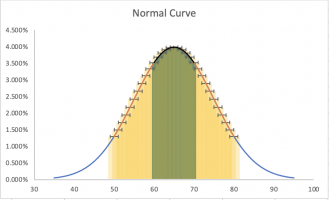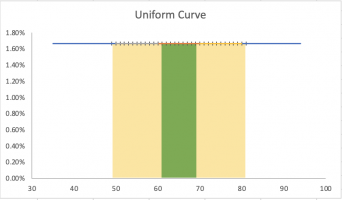Zermelo
Junior Member
- Joined
- Jan 7, 2021
- Messages
- 148
Hello there, I was thinking about some continuous probabilities, and came across this idea:
Let [imath]l\in R^2[/imath] be a smooth non-intersecting curve defined by the equation [imath]l: y = f(x), \ x\in [a, b][/imath], where [imath]f(x)[/imath] is a bijective function. What is the probability of selecting a point from the curve such that [imath] x \in [c, d] \subseteq [a, b] [/imath]?
I have 2 ways of thinking about this:
First, using the geometric definition of probability: let's define a curve [imath]l_0 \subseteq l,\ l_0: y=f(x), x\in [c, d][/imath], Then the probability of picking said point is the probability of picking a point from the curve [imath] l_0 [/imath], when choosing a random point from [imath]l[/imath]. So, the probability is: [math]p = \frac{Length(l_0)}{Length(l)} = \frac{\int_c^d \sqrt{1+y'^2}dx}{\int_a^b \sqrt{1+y'^2}dx}[/math].
On the other hand, the probability is simply [math]p = \frac{d-c}{b-a}[/math], because a point [imath](x, y(x))[/imath] will be on the curve [imath]l_0[/imath] when [imath]x\in [c, d][/imath], and it will be on the curve [imath]l[/imath] when [imath]x\in [a, b][/imath].
This is contradictory, because generally, [imath]\frac{\int_c^d \sqrt{1+y'^2}dx}{\int_a^b \sqrt{1+y'^2}dx} \neq \frac{d-c}{b-a}[/imath].
What is the right answer here, and why? Or is this a case of Bertrand's Paradox?
I myself lean more towards the second solution because I clearly stated in the problem "what is the probability of getting a point on the curve such that [imath] x \in [c, d] [/imath]?", (the set of all possibilities is [imath]\Omega = [a, b][/imath]). If this is the right answer (because of the problem formulation), what kind of problem would have the first answer as a solution? Could anybody give me an example?
Let [imath]l\in R^2[/imath] be a smooth non-intersecting curve defined by the equation [imath]l: y = f(x), \ x\in [a, b][/imath], where [imath]f(x)[/imath] is a bijective function. What is the probability of selecting a point from the curve such that [imath] x \in [c, d] \subseteq [a, b] [/imath]?
I have 2 ways of thinking about this:
First, using the geometric definition of probability: let's define a curve [imath]l_0 \subseteq l,\ l_0: y=f(x), x\in [c, d][/imath], Then the probability of picking said point is the probability of picking a point from the curve [imath] l_0 [/imath], when choosing a random point from [imath]l[/imath]. So, the probability is: [math]p = \frac{Length(l_0)}{Length(l)} = \frac{\int_c^d \sqrt{1+y'^2}dx}{\int_a^b \sqrt{1+y'^2}dx}[/math].
On the other hand, the probability is simply [math]p = \frac{d-c}{b-a}[/math], because a point [imath](x, y(x))[/imath] will be on the curve [imath]l_0[/imath] when [imath]x\in [c, d][/imath], and it will be on the curve [imath]l[/imath] when [imath]x\in [a, b][/imath].
This is contradictory, because generally, [imath]\frac{\int_c^d \sqrt{1+y'^2}dx}{\int_a^b \sqrt{1+y'^2}dx} \neq \frac{d-c}{b-a}[/imath].
What is the right answer here, and why? Or is this a case of Bertrand's Paradox?
I myself lean more towards the second solution because I clearly stated in the problem "what is the probability of getting a point on the curve such that [imath] x \in [c, d] [/imath]?", (the set of all possibilities is [imath]\Omega = [a, b][/imath]). If this is the right answer (because of the problem formulation), what kind of problem would have the first answer as a solution? Could anybody give me an example?


